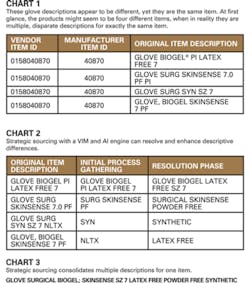| Todd M. Tabel, Vice President, ERP and Supply Chain Solutions, McKesson Provider Technologies – Health Systems Performance Management |
Your item master is your base source of information for so many of your critical supply chain activities – basic procurement, comparison to chargemaster, and the core information for standardization and value analysis efforts.
But what if your source of truth is not so truthful?
Hospital item masters are constantly being updated, and 30 percent of buyer systems are inaccurate. With hospital item master files ranging from 18,000 to more than 100,000 items, that translates to thousands of inaccurate or duplicate items.
Since the inception of the item master, much has changed – the addition of thousands of complicated products, multiple vendors, GPOs, diverse users and disparate locations. Today’s item master can’t supply the comprehensive, accurate, accessible supply chain data that healthcare systems need to support the enterprise. Providers need a better way.
The very nature of the item master is outmoded
So, let’s back up. How did the item master and current procurement processes get so far off course?
The item master was initially constructed to support product replenishment. A paper requisition sent to purchasing initiated item replenishment from a Central Supply department. The process evolved to become electronic, yet it still works much the same way as the paper process. The limited description fields (22 to 30 characters, including spaces) make items difficult to recognize, so users may order incorrectly, order off-contract or enter their own description for a product that already exists.
In addition, the sheer size of item masters and the number of users make housekeeping difficult. Often, new catalog information isn’t added in a timely fashion. Discontinued items aren’t deleted. Codes or descriptions aren’t typed correctly.
Consultants or data cleansing services may provide clean data for some point in time, but data leakage and discount loss leakage begins immediately, which then results in any savings being lost.
Furthermore, many purchases never make it into the item master to begin with, such as non-PO purchases that bypass the standard procurement process and avoid capture in the item master. Additionally, self-contracted items and Group Purchasing Organization (GPO) contracts are often not included in an organization’s Materials Management Information System (MMIS). This void in an organization’s supply spend and contract data limits the proper data needed for value analysis and standardization efforts. This causes further damage when you consider high-cost physician reference items, which can account for 60 percent of total supply expenditures and often dominate the total inpatient cost of a surgical procedure.
The item master’s limited product description fields, universal naming conventions and lack of visibility create a system that, by its obsolete design, cannot be accurate. In short, today’s item master, MMIS and/or ordering convention remain out of step with the needs of modern supply ordering.
The virtual item master and artificial intelligence: Your cloud has a silver lining
New strategic sourcing solutions can resolve many of the problems healthcare providers experience with current item masters and procurement processes. They help address the need to accommodate the myriad of users, locations and products, and expand the accessibility and accuracy of the data itself.
A core component of many modern strategic sourcing solutions is a virtual item master. Virtual item masters (VIMs) are cloud-based, Software as a Service (SaaS) offerings that expand the limits and capabilities of traditional item masters. VIMs are helping healthcare organizations to dramatically reduce costs by enabling more efficient maintenance of product content, standardization of item requests and enhanced user-search capabilities in a single electronic repository. It fully integrates with an organization’s MMIS and enterprise resource planning (ERP) solution.
At least one strategic sourcing solution takes this a step further by combining a virtual item master with an artificial intelligence engine. This combined approach offers a way to incorporate industry listings with all of an organization’s own supply chain data to normalize the universal data to a single source of truth. All of the organization’s supply chain data is captured and normalized with manufacturer catalog data. Information is continually updated and normalized so data stays “clean.” The user gains a consumer-type search capability, including photos, for easy identification.
And more than that, this approach supports standardization and value analysis efforts. Users benefit from improved data quality, comprehensive spend data and consumer-type search capabilities to easily identify, group and compare functional similar and functionally equivalent items to identify standardization opportunities. Organizations can reduce the number of vendors, enhance the strength of contracts and gain more accurate information to support “best value” initiatives.
How the VIM and artificial intelligence work together to drive data accuracy
One of the key roadblocks to better product standardization and contract compliance is the lack of fields for descriptive attributes. These cryptic, annotated supply management descriptions can be almost unintelligible to many users.
To illustrate the problem, we need only look at the product description format as shown in Chart 1, used by one organization with multiple hospitals, purchasing and requisitioning entities.
A strategic sourcing solution using a VIM and an artificial intelligence engine normalizes and expands attributable data elements, making the number of attributes virtually limitless. Disparate information from various item masters can be harvested and normalized, along with the inclusion of original vendor and contract descriptions, allowing for a consolidated description on which all users can agree.
Because the system is able to recognize different naming conventions for same or like items, it can readily identify functionally similar products (see Chart 2) so organizations can group and compare items for standardization (see Chart 3).
Conclusion
Today’s advanced strategic sourcing solutions utilize virtual item masters and artificial intelligence to improve data accessibility and accuracy for all players and locations in the supply chain – from clinical purchasers, in-hospital and off-site, to accounting and value analysis teams. Ultimately, these advanced strategic sourcing solutions can save your organization money by giving visibility into an organization’s supply purchases and contract activity, helping providers better control contract spend and achieve better product standardization, especially through identification and management of high-cost physician preference items.
- Global Data Synchronization Network, Current Facts About Data/Data Synchronization; AHRMM Website; accessed 3/14/2012.
- John Cashmore; “The Value of Cleansing Data”; Materials Management in Healthcare; 2005.
- “Reining in the Cost of Physician Preference Items”; HFMA Special Advertising Section, May 2010.
- Wilson, NA, Schneller, ES, Montgomery, K and Bozic, KJ; Hip and Knee Implants: Current Trends and Policy Considerations; Health Affairs (Millwood) 2008; 27 (6) 1587-1598; Nov/Dec 2008.
- “Finding Buried Treasure: Overcoming barriers to better spend management in healthcare;” Fuller, Krista; Health Management Technology, May 2011.



